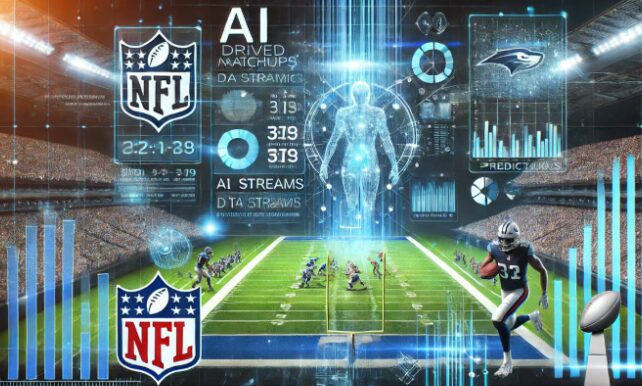This article dives deeply into how Next Gen Stats and advanced analytics are transforming NFL forecasting while honoring the enduring power of human instinct, examining psychologies of fan loyalty, AI-driven forecasting, the interplay of data and gut feeling, and how fantasy football and betting platforms now weave both strands together.
NFL Next Gen Stats
The NFL’s Next Gen Stats captures real-time location data, speed, and acceleration for every player on every play on every inch of the field.
Started with Zebra Technologies in 2014 using RFID tags in shoulder pads, tracking players 10 times per second, the system was adopted league-wide by 2017.
Metrics include speed, acceleration, distance traveled, completion probability, and expected points added (EPA).
For the 2024 season, new metrics like Tackle Probability and PAT Decision Guide were added to deepen performance evaluation.
AWS supplies the cloud infrastructure, powering real-time data ingestion, machine learning, and dashboards that produce insights within minutes.
AI and Big Data Bowl: AWS & Analytics Innovation
The NFL’s annual Big Data Bowl invites data scientists to create next-gen analytics models around pressure, tackling efficiency, and advanced decision-making.
Based on a submission to the Big Data Bowl, AWS and Next Gen Stats developed an AI-powered “Tackle Probability” model to assess the likelihood of successful tackles in near real time.
NFL teams are increasingly hiring Big Data Bowl participants—around 40 have been recruited by approximately 20 teams—while others have joined analytics firms such as Zelus Analytics, StatsBomb, and Telemetry Sports.
Broadcasting Meets Analytics: Prime Video & AI
Amazon Prime Video’s “Prime Vision with Next Gen Stats” leverages AI to overlay defensive alerts, prime targets, and pressure indicators directly onto live NFL broadcasts.
One example involved a linebacker rush prediction against Brock Purdy, which was highlighted on-screen and correctly executed during the play.
Switching to innovative skycam perspectives has dramatically increased viewer engagement, skyrocketing social conversations from roughly 4,921 mentions to over 315,000 during a span of seven games.
AI-driven tools now detect coverage schemes, highlight pressure situations, and expose offensive vulnerabilities, helping fans understand tactical dynamics better than ever.
Psychology of Fan Loyalty & Mock Drafts
Fans’ fascination with mock drafts stems from psychological drivers like hope, team identity, escapism, and “metafandom,” where the act of discussing the sport becomes its own form of entertainment.
Joel Buchsbaum’s obsessive accuracy in early draft projections laid the foundation for today’s mock-draft craze, inspiring experts like Jason Boris, who now consistently ranks among the most accurate mock drafters.
Benjamin Robinson’s aggregation of thousands of mock drafts produces highly reliable statistical ranges and correctly predicted 83 of the top 100 picks in a recent draft.
NFL teams such as the Cleveland Browns have adopted Robinson’s aggregated insights for their pre-draft strategies, leveraging collective data to reduce bias.
Fantasy Football & Betting: Analytics and Instinct
Fantasy football has evolved into a highly data-driven experience, as analytics increasingly shape how fans evaluate players and make roster decisions while blending seamlessly with betting markets.
Fantasy and betting platforms now integrate projections, community polls, and user engagement metrics to illustrate how player forecasts mix mathematical rigor with human psychology.
AI-powered deep learning pipelines processing over 100,000 daily data sources have achieved 72% classification accuracy in player performance categories, such as boom, bust, or injury risk, with an RMSE of just 6.78 points for the top 500 players.
Models combining statistical data, betting markets, and both public and expert opinions have outperformed purely statistical predictors by more than 300 points in fantasy leagues. NFL fantasy football mobile apps play a central role here, merging AI-driven projections with fan-driven instinct. Users toggle between cold, number-based recommendations and bold, instinctive calls, reflecting a balance between analytics and passion.
Betting Lines, Odds, and Human Bias
Analysis of 2,560 NFL games between 2002 and 2011 revealed that shifts between opening and closing betting lines could predict divisional winners with at least 75% accuracy.
Home underdogs covered the spread 47% of the time, yet consistently betting on them would have yielded a 53.5% win rate—above the break-even threshold of 52.38%.
Advanced models that exploit oddsmaker biases have outperformed traditional prediction systems, proving that human tendencies and algorithmic behaviors both influence betting outcomes.
Data-Driven Decision Making in NFL
Teams like the Cleveland Browns have embraced analytics-driven draft strategies, trading down to maximize pick value and prioritizing data-driven evaluations based on production metrics and athletic testing.
On the field, fourth-down calls and other high-pressure decisions are increasingly guided by analytics rather than conventional wisdom, reflecting a shift toward evidence-based coaching strategies.
Football Outsiders & DVOA
DVOA, or Defense-adjusted Value Over Average, measures team success relative to league averages in specific down-and-distance situations, adjusting for opponent quality.
Historical DVOA data from 2000 through 2018 reveals meaningful patterns, such as the 2010 New England Patriots achieving a 45.7% offensive DVOA, while the 2018 Kansas City Chiefs posted a 34.8% figure, underscoring their dominance in those respective seasons.
Synthesis: Analytics vs Instinct in NFL Forecasting
Next Gen Stats, AI-based models, DVOA metrics, and betting-line analytics now empower teams, broadcasters, and fans with unprecedented insights and prediction accuracy.
Yet the human element persists—gut instinct, bold fan narratives, and loyalty-driven predictions still shape perceptions and decisions.
The future of NFL forecasting lies in harmonizing analytics with instinct, combining smart predictive models with the drama and emotion of human decision-making.
Fan investment adds another dimension: predictions are not just about outcomes but also reinforce identity, community, and hope.































